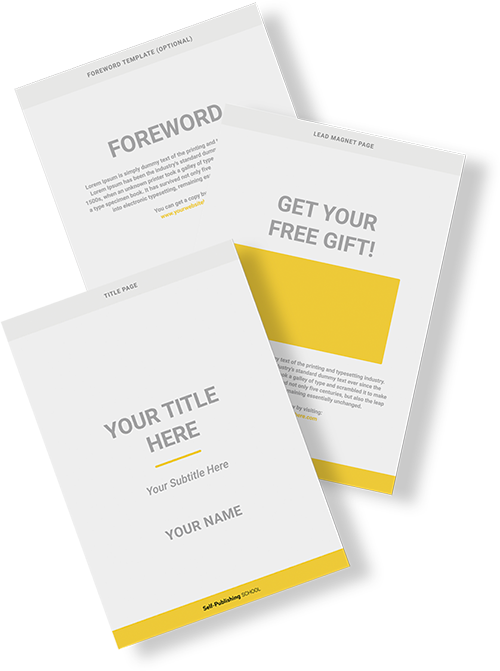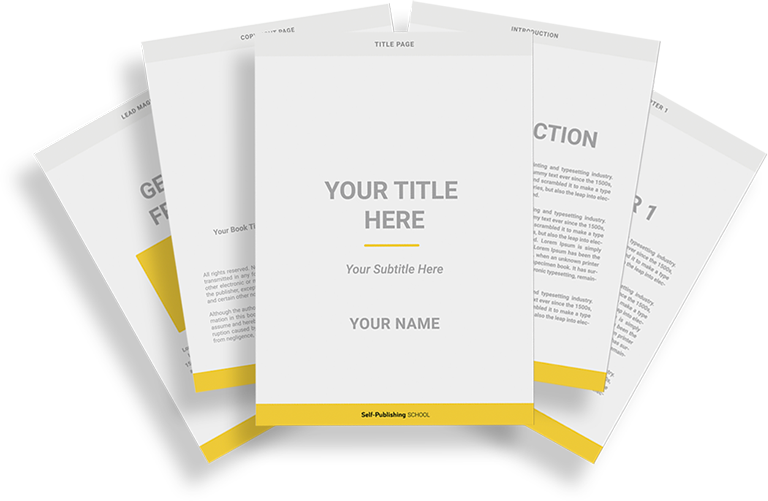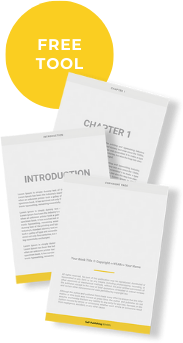Book templates can save you so much time.
Have you ever gone on a road trip with no idea where you’re headed? A fun adventure, maybe, but sometimes we don’t want to waste that kind of gas.
To get to our destination as efficiently and as low-effort as possible, we grab ourselves a roadmap and make a plan.
That’s what a book template can do for your writing process.
Some writers might prefer “discovery drafts,” where you start writing to see where it ends up. Some people will even tell you not to use a book template at all (from our experience helping thousands of people write and publish books, we think not using one will only lead to your own frustration and lack of progress).
To each their own! But if you’ve clicked on this post, you’re probably interested in a more direct route to writing a strong book and publishing your book successfully.


Book Outline Generator
Choose your Fiction or Nonfiction book type below to get your free chapter by chapter outline!
Book Outline Generator
Enter your details below and get your pre-formatted outline in your inbox and start writing today!
CONGRATULATIONS
Thanks for submitting! Check your email for your book outline template.
In the meantime, check out our Book Outline Challenge.

Let’s talk about the roadmap of book writing to get you there quicker:
- What is a book template?
- Contents of a book template
- Fiction book template
- Nonfiction book templates
- Nonfiction book frameworks
- Sequential template
- Numerical template
- Problem-solution template
What’s a book template?
There are tons of forms of book templates for different genres and preferences, but a book template is essentially a plan for what to include in your book and where it goes. This can streamline the process from writing to publishing, getting your book done a lot quicker than if you were winging it.
So why should you use a book template? A template is your roadmap. Knowing where you’re going will help you foresee obstacles, plan ahead, and get to your destination quicker.
Why waste time muddling through the order and format of a book, when you can just use a template and know exactly what you need to get done?
Before we talk about what might go into a book template, I want to mention my biggest tip for using them: personalization. Making your own template would ensure that it suits your needs and style. Feel free to take the elements listed in this blog, tweak and customize, then save YOUR book template to use for future projects.
Want to just grab a book template easily? Fill in this form and check your inbox!
Contents of a Book Template – For Nonfiction & Fiction
Let’s look at the content you might find in a book template. The elements might be different based on the genre, particularly between fiction and nonfiction works.
Fiction Book Templates
We’re going to cover a fiction book template first, because fiction should have fewer sections and subsections–it will most likely be separated by chapters because fiction is almost always meant to be read linearly.
An example of a fiction book that might be read out of order is a Choose Your Own Adventure book, or something else that turns a story into a unique format. But most often, fiction books are read from beginning to end, which makes a novel template very straightforward.
Here are the contents of a fiction book template:
- The title. Every book needs a title! Besides the cover, your title will appear on the title page and the half-title page inside of the book, along with any subtitles and your name or pseudonym. Here’s an example of the title and half-title pages from my latest publication, Starlight:
- Copyright page. The fine print of all things legal. Your copyright page includes the copyright statement and other legal details. It might also include information like the editor of the book, other contributors, or disclosures and content warnings.
- Self-promo (optional). This page might be where you promote your other books or plug social handles or a newsletter. This is a great page to have if you own a business, a website, or have multiple publications. Any opportunity to reference somewhere your readers can find more content can only work to your advantage.
- Acknowledgments (optional). The section might appear before your main book content or at the end. This is where you thank people who helped with the book, in life, or whatever else.
- Table of contents. This is a breakdown of what is in your book and where. In fiction, this will likely be a list of chapters. If the chapters don’t have titles and the book should always be read in order, you might not exclude the table of contents page. Since Starlight is a collection of short stories, I included a table of contents page in case someone wants to find a particular story on their second read:
- Prologue (optional). A prologue is a small snippet of story in the same universe as the rest of the book, but far apart from the actual story. The prologue might be a peek into the very distant past or very distant future, or it might be from a perspective different from the perspective for the rest of the book. Not every book needs a prologue, but most fiction templates will have a place for you to insert one.
- Dedication (optional). This is the page you’ll see with a small ode to someone else, like “for my mother” or “to all lost children.” The dedication page is a small area to acknowledge who your story was written for. Here’s an example of the dedication page from Starlight:
- The story itself! Maybe it’s a three act structure, maybe it’s The Snowflake Method, maybe it’s a different format, or maybe your template just says “STORY HERE.”
- Review ask. This is something you’ll commonly see in ebooks and self-published books, where the writer asks the reader to leave a review at the end of the book. This is a great opportunity to up your book stats, but it’s obviously optional.
- Read more. This is another optional opportunity to push readers toward your other works. You’ll see this page at the end of most books, especially for series, titled something like “also by the author” with a list of their other works.
- Author bio. A strong author bio is a great tool to have, so spend a minute on it. Snag someone’s interest to look more into your work or writing with a cleverly composed author bio.
This list covers most elements you’d see in a fiction book template. Tweak it and twerk it to your preferences, then save your template for future books!
Grab a fiction-specific book template by filling out the form below:
Nonfiction Book Templates
Nonfiction can have a much wider range of elements because writing a nonfiction book requires you to follow a wider range of formats, but you’ll see a lot of the same elements we saw in fiction templates.
Here are some things you might see on a nonfiction book template:
- Title and subtitle
- Your name or pseudonym
- Copyright page–gotta have that fine print.
- Lead magnet. This is a great space to offer a free gift in exchange for people doing things like joining your mailing list, checking out your other books, following you on social media, or anything else you’d like to direct traffic toward.
- Dedication (optional)
- Table of contents. In nonfiction, you’ll almost always see a table of contents. Unless it’s a memoir, most nonfiction pieces can be read in chunks, not necessarily in order. A reader might read it once, then go back to refer to certain bits later, so having a clear and thorough table of contents can really make utilizing your nonfiction book easier for readers.
- Foreword (optional). A foreword is kind of the nonfiction version of a prologue. Either the author, editor, or someone else responsible for putting the book together might address the reader in a foreword to provide context or scope for the book they’re about to read.
- Introduction. A forward and book introduction might look like very similar things, but an introduction should specifically tell your reader what to expect from the book. In nonfiction, your introduction should cover several things:
- Identify the problem–plainly state why the reader is here. What problem do they have that the book or course will solve?
- Present the solution–explain that you have the answers to their problem.
- Reassert your credibility–why are you qualified to give advice on this subject? Give specific reasons you’re qualified.
- Show them the benefits again–look at this solution you have! It’s so helpful! They should definitely read this book to get the answers.
- Give them proof–have your methods been successful? Do you have numbers that prove it? Is your own life a reflection of how your advice applied can be beneficial and fix the stated problem?
- Make a promise–what will you do for the reader? How will reading this book and applying the advice and wisdom change their life? Aim big!
- Warn them against waiting–why do they need to do it now? What are the possible repercussions of not taking action on the stated issue?
- Prompt them to read (call to action)
Now for the content of the book itself–a nonfiction book could have a few different structures and frameworks depending on what your book is about.
Nonfiction Book Template Frameworks
Let’s look at three different types of nonfiction frameworks–sequential, numerical, and problem/solution.
Book Structure 1: Sequential Framework
The Sequential Framework arranges information according to a step-by-step sequence. This framework is most effective for books that are written to describe a step-by-step process.
A book that follows this type of framework is one by Lise Cartwright, Side Hustle Blueprint: How to Make an Extra $1000 in 30 Days Without Leaving Your Day Job!
The layout for a nonfiction using the sequential framework might look like this:
Step 1:
Chapter 1 – First part of the process
Chapter 2 – Second part of the process
Chapter 3 – Third part of the process
Step 2:
Chapter 4 – First part of the next step
Chapter 5 – Second part of the next step
Chapter 6 – Third part of the next step
Et cetera, until the steps of the process are complete.
Book Structure 2: Numerical Framework
The Numerical Framework organizes information by listing a specific number, keys or rules to support the author’s point, then uses smaller chunks of content to support the key/rule.
A book that follows this type of framework is 7 Habits of Highly Effective People by Stephen R. Covey.
Number 1:
Chapter 1 – Introduction to the point
Chapter 2 – Supporting content
Chapter 3 – Summary of the point
Number 2:
Chapter 4 – Introduction of the next point
Chapter 5 – Supporting content
Chapter 6 – Summary of the point
Structure 3: problem/solution framework
Book Structure 3: Problem-Solution Framework
A problem and solution framework organizes information so readers are able to clearly identify a problem and understand the solution you have to offer. This framework is often used in combination with the numerical framework.
A book that follows this type of framework is Hal Elrod’s The Miracle Morning: The not-so-obvious secret guaranteed to transform your life before 8am.
Main Problem:
Chapter 1 – Introduction to the problem
Chapter 2 – How the problem came to be
Chapter 3 – Impact of the problem on the reader
Main Solution:
Chapter 4 – Introduction to the solution
Chapter 5 – Supporting content
Chapter 6 – Supporting content
Chapter 7 – Supporting content
Chapter 8 – Next Steps
Those are three common frameworks for structuring the actual content of a nonfiction book. Again, templates should be customized for the specific writer and book, so feel free to take these elements and alter them into whatever format would best suit your needs!
Book templates are a powerful tool in organizing your books and streamlining the writing and publishing process. Seeing exactly what needs to be done helps you organize a plan to do it efficiently and effectively.


Book Outline Generator
Choose your Fiction or Nonfiction book type below to get your free chapter by chapter outline!
Book Outline Generator
Enter your details below and get your pre-formatted outline in your inbox and start writing today!
CONGRATULATIONS
Thanks for submitting! Check your email for your book outline template.
In the meantime, check out our Book Outline Challenge.
